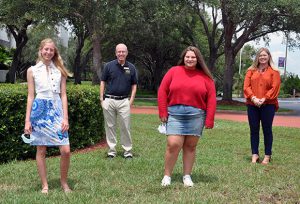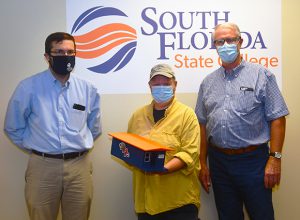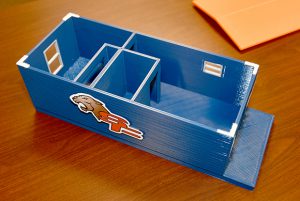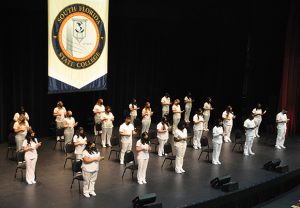AVON PARK, Fla. – Aug. 31, 2020 – A hurricane broke through the Lake Okeechobee dike in 1926, devastating the town of Moore Haven, Fla. The flood waters washed away homes and drowned many of the town’s residents. A little known mass grave in Pinecrest Cemetery in Sebring, Fla. holds the secret of their demise. Because of their research on the disaster, two South Florida State College (SFSC) students, Camila Rimoldi Ibanez and Kyria Wickham, have assisted in bringing the Moore Haven story to light and honor its victims.
That research was published in the fall 2020 issue of the “Journal of Multidisciplinary Research.” The research article is titled, “Disaster at Moore Haven: How the 1926 Great Miami Hurricane Destroyed a Small Town on the Shores of Lake Okeechobee.”
“It’s extremely important for students to know that they can work on a project and get recognized in this way,” said Dr. James Hawker Jr., SFSC dean of arts and sciences. “Two of our undergraduate students published research. I’ve never see this before. Students become engaged in learning so much more than in the classroom by participating in these kinds of undergraduate research projects.”
Rimoldi and Wickham are both dually enrolled at Sebring High School and SFSC. They’re also members of SFSC’s Honors program. In their first semester at SFSC, they took Dr. Charlotte Pressler’s Honors Freshman English I class. Dr. Pressler, who recently retired from SFSC, had heard from local historians at the Avon Park Depot Museum about the Moore Haven hurricane and that few people knew many of the details. So she proposed the topic to her Honors Freshman English I class as a research project. According to Wickham, the mass grave at Pinecrest Cemetery is difficult to find. “We wanted to, eventually, recognize the victims, maybe through a state grant and funding, with a bronze plaque,” she said. “That was the goal of the project.”
Each student involved in the project took on specific aspects of the disaster. “Being the science person that I am, I tried to focus on how and why the dikes and the town failed to protect the people,” Rimoldi said. “Back then, there weren’t really any building codes. The residents were just building houses that were made from materials immediately available to them. So, I researched why and how the dike failed during the storm.”
Wickham focused on researching the victims—the number of victims in the mass grave and how they came to a resting place in Sebring, the body recovery process, and the forensics that were done. She had some early successes and ran into a few snags. “I communicated with the Stephenson-Nelson Funeral Home and received documents from them about the hurricane and how they traveled down to Moore Haven at that time and helped with the body collection and identification process.” Wickham drew information from documents provided by the Sebring Historical Society, and she and Dr. Pressler attempted to find relatives of hurricane victims to gather oral histories. However, they found that the survivors had said little about the disaster to their family members. Wickham also found it difficult to gather forensics information. “There wasn’t much in the way of forensics back in the 1920s—it was just starting as a practice,” she said.
“There are multiple racial aspects to the research that I didn’t expect to come across,” Wickham said. “Moore Haven was an agricultural area with a lot of laborers who were from elsewhere, some were Hispanic, and some African American. There are a lot of differences in the number of people who died and survived because whites were given priority during that time.”
Rimoldi and Wickham’s research first went public when they presented posters at two undergraduate conferences—the Florida Collegiate Honors Conference and the Florida Undergraduate Research Conference (FURC)—in February 2020. Wickham networked while at FURC and met Dr. Donald Duke, an ecology and environmental studies professor from Florida Gulf Coast University (FGCU), who was interested in continuing the research on Moore Haven.
Rimoldi and Wickham feel that their research on the Moore Haven disaster is significant for the residents of South and Central Florida. “Bringing events to life and understanding what happened shows respect for those who lost their lives, lost their homes, lost their family in such an event. If I was in their shoes, what would I want to be done or what would I have done?”
Wickham said, “It reveals a part of local history that we didn’t know we had. It helps us recognize individuals who went through severe times and now they can be recognized and identified. And we can just keep telling their story.”
Rimoldi and Wickham both look forward to graduation from high school in spring 2021 and earning their Associate in Arts from SFSC in May 2021. Wickham plans to major in biochemistry and wants to be a research scientist working on genetics. She’s currently considering attendance at the University of Central Florida, Florida Gulf Coast University, or the University of Florida. Rimoldi plans to major in marine biology with an eye toward continuing her education at the University of Miami or the University of Chicago. “Ultimately, I want to become a researcher, specifically, to help coral with all the bleaching epidemics going on right now. I want to help that type of ecosystem.” Coral bleaching is stress often caused by the rise in ocean temperatures. When the temperatures remain high, coral release symbiotic algae. Over time, without the algae, the coral can die.
“Undergraduate research allows students to dig deeper into an area of interest,” said Amy Bohan, SFSC Honors Program director and biology instructor. “It allows more one-on-one time with the instructor and allows them to learn a new skill set. For example, they can learn laboratory techniques if they’re working in our science labs. The students will have networking opportunities if they attend and present their data at undergraduate conferences. Undergraduate research also helps in building students’ resumes for when they apply to transfer to a university or when applying for specific programs.”
Bohan said that research opportunities for students at SFSC are plentiful in the Humanities and the Natural Sciences. Research projects have been done on the Moore Haven disaster, industrial hemp for the removal of contaminants in rivers and lakes, canine congestive heart failure, growth factor genes in endothelial cell and neuron function, and on mechanisms of apoptosis (programmed cell death).
Students who are interested in becoming involved in the SFSC Honors Program may contact Bohan at bohana@southflorida.edu or 863-784-7362. To become involved in a research project at SFSC, students may contact Bohan, Dr. Hawker at hawkerj@southflorida.edu or 863-784-7329, Dr. Daniel Sanches at daniel.sanches@southflorida.edu or 863-784-7360, Dr. Mintoo Patel at Mintoo.Patel@southflorida.edu, or Dr. Theresa James at JamesT@southflorida.edu or 863-784-7185.
AVON PARK, Fla. — Aug. 26, 2020 — Leslie Behm, CEO of Hope Haven Transitional Housing, has a dream to help her clients in Highlands County get back on their feet by offering them a place to call their own. Those clients are homeless veterans, elderly, individuals, and families. When she spoke with Dr. Thomas C. Leitzel, president of South Florida State College (SFSC) about her plan, he saw a way to benefit her organization as well as the College’s students. So, later in the fall term, SFSC students in Basic Carpentry/Roofing and Basic Construction-Electrical classes will begin work on two tiny homes for Hope Haven.
SFSC recently started a Construction and Utility Trades program that offers eight-week courses in Basic Carpentry/Roofing, Basic Masonry, Basic Construction Plumbing, and Basic Construction-Electrical.
“Our Basic Carpentry/Roofing course kicked off on Aug. 3 and the Basic Construction-Electrical kicked off on Aug. 10,” said Fred Hayes, coordinator of SFSC’s Trades program. “Once the students get to the midpoint in their training, we should be able to spend time in the field working on these projects for about three or four weeks. Then, when the next class rolls around, it’ll be a four-week delay before we get back again because the next class needs its four weeks of in-house training. Then we can go back out and work on the tiny house.”
Behm’s plan is to begin her multiphase project by building eight tiny homes. “They’re going to be located at EO Douglas Avenue in Sebring,” she said. “It’s close to the Highlands County School Board.”
Unlike the tiny homes audiences see on television programs that focus on home design, decorating, and rebuilding, Hope Haven’s tiny homes will be more modest in cost and design. “These are not $40,000-$60,000 homes,” Behm said. “These are under $8,000 homes which is much more affordable for everyone involved. They’ll have everything that you and I have—a living room, a bedroom, a bathroom, and a kitchen. They’ll be 386 sq. ft. They’ll be efficient, so the electric bill is not going to be $200-300 a month and the water bill won’t be $100. These homes will be something that my clients can afford. These first eight homes will be for singles or couples only.”
Hayes and the SFSC Trades program students will be ready to go to work shortly. “Leslie Behm said the septic systems will be put in before we get there and then we could have the reigns on the project to pour the concrete pad and get it ready to go. Then we’ll work on the framework, the rough structure, and do the drywall work, as well as build the roof. The electrical class would do the electrical work on the inside, so this project benefits students in our Trade programs.”
The community and Highlands County have gotten behind the tiny house program. “This project will be going forward with the help of the community, especially churches,” she said. “Several churches have stepped up and really provided a good backing.”
Behm has plans to build tiny houses on other sites in Highlands County and indicated that private citizens have donated land. However, she continues to speak to groups in the community to explain what the tiny house project is and what the houses will look like. To assist Behm in her efforts, Garrett Lee, SFSC Engineering program coordinator, created a miniaturized model of the tiny house with the aid of the College’s 3D printer. “People can actually see the tiny house in a full 3D view and understand a little better than having to figure it out based on the plans and layout. We were able to put together a prototype of the house in a couple of days. We printed the main body in one day and printed the roof another day, then put the two together.”
Lee explained that 3D printing is a component of Mechatronics—computer-controlled manufacturing. He explained that 3D printing is useful for rapid prototyping or one-offs. “In this case, we were able to come up with something and hit ‘print.’ The next day, you may want to tweak it a bit, hit ‘print,’ come back and check it again. To try to have this made out of something else would have been to do it with molding. You’d have to craft the dies and then it would be a month-long project. If something wasn’t right, you’d have to mold a whole new set of dies.”
“I’ve done a lot of presentations to churches, Rotary clubs, and private groups that are interested in the project and to individuals who want to help,” said Behm. “They want to know exactly what it is I’m talking about and they want to see it. Garrett knocked the model out of the park. The 3D tiny house model is small enough and lightweight enough that I can turn it around when I do presentations, and everybody will understand and see what I’m talking about.”
Behm is passionate in her assistance to the homeless in Highlands County and has maintained the Safari Inn in Sebring as a refuge. “We have a need in Highlands County for affordable housing for the homeless. Our facility at the Safari Inn is constantly filled, so I decided that we’re going to build tiny homes so we can move people out of this facility into their own places. These homes will provide normalcy for them. Everybody thinks that because someone is homeless, it’s because of drugs or alcohol. But that’s not the case for some of these people. Some have just fallen on hard times, and now with COVID-19, everyone’s fallen on bad times. For instance, we have families — mom and dad just lost their jobs, lost their home, and have nowhere else to go, so they’re out there.”
“It’s been hard work finding good people who understand the need and everything that has been donated. But I love what I do,” she said. “I just want to see it through and get this rolling and show everyone what we’re talking about.”
For detailed information about any of SFSC’s Construction and Utility Trades courses, see the catalog at southflorida.edu/corpedschedule, call 863-201-7195, or email corporatetraining@southflorida.edu. To register for any of the Construction and Utility Trades courses, call 863-784-7405.
To learn more about SFSC’s Mechatronics program, visit southflorida.edu and look under “Future Students” and “Degrees & Programs,” email leeg@southflorida.edu, or call 863-784-7439.
 AVON PARK, Fla. — Aug. 24, 2020 — South Florida State College (SFSC) has been awarded special funding through Florida Governor Ron DeSantis’ Emergency Education Relief (GEER) under the Coronavirus Aid, Relief, and Economic Security (CARES) Act, Rapid Credentialing, to assist in educational training for residents who are unemployed, underemployed, or furloughed.
AVON PARK, Fla. — Aug. 24, 2020 — South Florida State College (SFSC) has been awarded special funding through Florida Governor Ron DeSantis’ Emergency Education Relief (GEER) under the Coronavirus Aid, Relief, and Economic Security (CARES) Act, Rapid Credentialing, to assist in educational training for residents who are unemployed, underemployed, or furloughed.
Governor DeSantis allocated a total of $35 million to support Florida College System (FCS) institutions, such as SFSC, and district postsecondary technical centers in their ability to enroll and complete students in short-term, in-demand workforce/career and technical education (CTE) credentialing and certificate programs.
SFSC has been awarded $292,096 with the requirement of an additional 25% through matching funds for a total of $365,120. Matching dollars will come through the CARES Act Institutional funding ($23,472) and Perkins Career and Technical Education Act of 2016 (Perkins V) funding ($60,414). The Rapid Credentialing funds must be used by the end of May 2021.
“During the ongoing coronavirus pandemic and time of economic uncertainty, we are delighted to be able to enhance our program offerings and focus on helping individuals in our communities earn a short-term certificate or credential,” said Erik Christensen, SFSC dean of applied sciences and technologies. “As always, our goal is to help people get a job, keep a job, or be promoted in a job, and this grant is helping us do just that.”
Funds are focused on providing those unemployed, underemployed, or furloughed with training in an in-demand area of the regional workforce board. Funds will be used to purchase necessary equipment and underwrite costs associated with administering in-demand, non-credit industry certification preparation, clock hour career certificate programs, as well as for-credit, short-term CTE courses/programs. SFSC will use the funds to purchase equipment, personal protective equipment (PPE), recruiting, software, and instructor salaries to enhance the student learning experience.
The Rapid Credentialing funds will support SFSC students enrolled in these programs and courses: College Credit Certificates in Automation, CNC Machinist/Fabricator, Engineering Technology Support Specialist, Lean Manufacturing, Emergency Medical Technician (EMT) and Landscape & Horticulture Professional; Career Certificates in Firefighter I or Firefighter II, Automotive Service Technology, Correctional Officer, and Phlebotomy; Non-credit Continuing Workforce Education (CWE) Pre-Apprenticeship Certificate in Carpentry/Roofing as well as Electrical, Nursing Assistant, Real Estate, Welding, and the Commercial Driver’s License (CDL) Class A and B.
Scholarships toward these programs may be available through CareerSource Heartland. To learn more, visit CareerSource Heartland’s website at careersourceheartland.com or call one of the local CareerSource Heartland Career Centers: in DeSoto County at 863-993-1008, in Hardee County at 863-773-3474, in Highlands County at 863-385-3672, or in Okeechobee County at 863-610-6000.
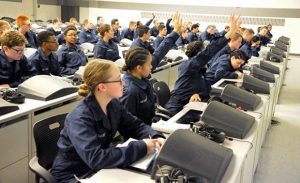 AVON PARK, Fla. – Aug. 19, 2020 – South Florida State College (SFSC) has entered into a contract to provide educational services for the newly formed U.S. Naval Community College (USNCC). SFSC is one of 119 colleges across the country contracted to provide distance learning training for active duty Sailors, Marines, and Coast Guardsmen.
AVON PARK, Fla. – Aug. 19, 2020 – South Florida State College (SFSC) has entered into a contract to provide educational services for the newly formed U.S. Naval Community College (USNCC). SFSC is one of 119 colleges across the country contracted to provide distance learning training for active duty Sailors, Marines, and Coast Guardsmen.
“We will start enrolling active duty members of our armed forces this fall for our spring term that begins in January 2021,” said Erik Christensen, SFSC dean of applied sciences and technologies. “This will include online College Career Certificates and four Associate in Science degrees. Although outside the scope of this partnership, these students could also continue with SFSC and work toward two fully online bachelor’s degree programs.”
The programs SFSC will make available to the USNCC will be Associate in Science degrees in Network Systems Technology, Health Services Management, Business Administration, and Accounting Technology. College Credit Certificates may be obtained in Network Security, Health Care Services, Business Management, and Accounting Applications. Other programs available will be the Bachelor of Science in Nursing and Bachelor of Applied Sciences in Supervision and Management.
The USNCC will provide a college education to the enlisted force to enhance combat and deterrence effectiveness of the Navy, Marine Corps, and Coast Guard. Sailors, Marines, and Coast Guardsmen will be enrolled automatically in the USNCC at the time of enlistment to demonstrate the importance of education to a naval career and to return to civilian life successfully. This not only helps the individual Sailor, Marine, or Coast Guardsman, but provides the armed services with more technically trained members which will result in greater warfighting potential.
The main features of the USNCC include conferring transferable and recognized associate-level academic degrees and certifications, providing flexible delivery methods to account for operational demands and technological constraints of a globally distributed workforce, developing academic programs in alignment with the needs of the Navy, Marine Corps, and Coast Guard as well as recognizing various forms of learning obtained through military technical and leadership training.
“We are excited about the possibilities that this partnership brings to the College,” Christensen said. “Aside from the fact that this will provide an additional source of student enrollment to SFSC in our online programs, the College is honored to be able to play a role in helping to support and strengthen our country’s armed forces through education. As a retired naval officer, I am thrilled at the opportunity to be able to help our nation’s armed forces take advantage of this wonderful opportunity to enhance their education while they serve our great nation.”
The first pilot of the USNCC will begin in January 2021 with approximately 500 active duty Sailors, Marines, and Coast Guardsmen. The second pilot will start in January 2022 with 5,000 students. For the first year or two, students will be selected to participate in the USNCC as the concept is proven and while the Navy works to win authorization from Congress to continue and grow. Once the USNCC is up and running at scale, open enrollment will be offered to the entire enlisted force. Full-scale operations with up to 25,000 students are expected to start in January 2023.
For more information on USNCC and SFSC partnership, contact Dean Erik Christensen at erik.christensen@southflorida.edu or 863-784-7424.
AVON PARK, Fla. – Aug. 13, 2020 – South Florida State College (SFSC) is offering a non-credit Nursing Assistant program at its Hardee Campus in Bowling Green, beginning Tuesday, Sept. 15. The program will be held on Tuesdays and Thursdays, 6 to 9:30 p.m. and on Sundays, 7 a.m. to 3:30 p.m. Funding opportunities for the Nursing Assistant program are available.
Nursing assistants can be employed in a variety of health care settings, such as outpatient clinics, hospitals, and long-term care facilities. A nursing assistant works under the supervision of a licensed practical nurse or registered nurse and may assist with personal care; patient mobility; activities associated with nutrition and hydration; maintaining safe patient environments; and collecting basic patient data. It is an entry-level nursing option that may assist students in career exploration or future academic endeavors.
To register for this program or for more information, call the SFSC Corporate and Community Education Department at 863-784-7034. For further information about this program, email corporatetraining@southflorida.edu or see the Health and Public Safety catalog at southflorida.edu/corporatetraining.
All SFSC classes will follow the Centers for Disease Control and Prevention (CDC) guidelines.
AVON PARK, Fla. – Aug. 6, 2020 – South Florida State College (SFSC) graduated 25 Practical Nursing (PN) program students in a traditional pinning ceremony on Thursday, July 30 in the Alan J. Wildstein Center for the Performing Arts at SFSC on the Highlands Campus in Avon Park. During this year’s ceremony, graduates, faculty, and members of the audience paid heed to the COVID-19 pandemic by donning masks and maintaining social distancing.
The graduates are Musa Najeh Abuelouf, Rigenst Alfred, Erica Alonso, Maimuna Bojang, Cassandra Byler, Mayra Cardenas, Khalaya Clarke, Rebeca Marie Cortez, Amy Davila, Jackeline DeLa Cruz, Uriel Estrada, Mayra Eugenio-Badillo, Maria I. Gonzalez, Britanya Graham, Laura Holden, Kaylon Johnson, Amy Knighton, Rebecca Lieder, Megan McCullough, Betsabet Montoya, David Rubinos, Noemi Secundino, Amber Shoemaker, Cassandra Sullivan, and Crystal Valadez.
Class president, Cassandra Sullivan, presented her farewell address to her fellow classmates: “Many words describe a nurse. But the one word that stands out to me is, ‘adaptable.’ We learn early in nursing school to be adaptable. Nursing students make many sacrifices. Nursing school is not for the weak. Say goodbye to your family and social life. We spend hours studying and fall asleep studying, just to wake up to study again. Sleep, eat, study, repeat. There is information overload, and we must learn it all in 11 months. We have given ‘adaptable’ a whole new meaning. I believe that this is a skill that we have all conquered and will use for the rest of our careers.”
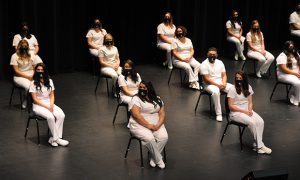 Sullivan recounted the challenges of nursing school during the pandemic. “We have Zoomed and recorded head to toe assessments that took 23 hours to upload. We did group work over the internet with practically dial-up speeds. Losing internet connection during a test or waking up to no internet connection made it challenging to complete assignments.”
Sullivan recounted the challenges of nursing school during the pandemic. “We have Zoomed and recorded head to toe assessments that took 23 hours to upload. We did group work over the internet with practically dial-up speeds. Losing internet connection during a test or waking up to no internet connection made it challenging to complete assignments.”
“We have given ‘adaptable’ a whole new meaning,” Sullivan said. “We will always be remembered as the practical nursing class that survived quarantine.”
Each year, PN graduates award the Golden Duck to someone who has served as a mentor to the students in the program. The D.U.C.K. acronym represents the foundational elements of the mentoring arrangement: Developing, Understanding, Compassion, and Knowledge.
During the ceremony, class secretary Noemi Secundino presented the 2020 Golden Duck Award to Patti Cardin, SFSC Nursing instructor. “[She] faced many challenges during her first year as an instructor, including the change to online teaching halfway through the year. She has consistently devoted her time to support and encourage us. She has not only been an amazing instructor but someone who was always willing to lend a listening ear. We adore, admire, and respect her greatly. She has had all the patience in the world to make sure our questions were always answered even after long, eight-hour days.”
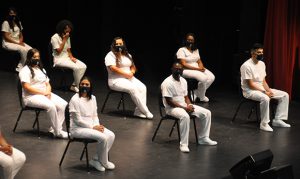 The practice of pinning new graduates has been a nursing school tradition in the United States since 1916 and, symbolically, welcomes each graduate into the nursing profession. The pin is worn prominently on a nurse’s uniform throughout her or his career. One story of the ceremony’s beginning goes back to 1883, when Queen Victoria awarded Florence Nightingale the Royal Red Cross on St. George’s Day for her service to the sick and injured during the Crimean War. In turn, Nightingale later extended the honor to her outstanding nursing students by presenting them with a medal of excellence.
The practice of pinning new graduates has been a nursing school tradition in the United States since 1916 and, symbolically, welcomes each graduate into the nursing profession. The pin is worn prominently on a nurse’s uniform throughout her or his career. One story of the ceremony’s beginning goes back to 1883, when Queen Victoria awarded Florence Nightingale the Royal Red Cross on St. George’s Day for her service to the sick and injured during the Crimean War. In turn, Nightingale later extended the honor to her outstanding nursing students by presenting them with a medal of excellence.
Graduates of the 11-month occupational certificate PN program become licensed practical nurses by passing the National Council Licensure Examination for Registered Nurses (NCLEX-PN) exam. SFSC nursing graduates are usually fully employed in nursing within a few months of graduation.
SFSC offers an Associate in Science degree in Nursing (AS) program for students interested in becoming registered nurses: a two-year Generic-RN program and a one-year Transition-LPN to RN program. The College also offers a Bachelor of Science in Nursing (BSN) program. For program entry requirements, consult the SFSC College Catalog online at southflorida.edu, call 863-784-7225, or email healthsciences@southflorida.edu.
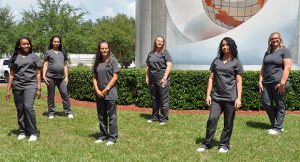
Graduates: Jesula Bellegarde (left), Jennifer Garcia, Holly Lang, Tonya Rowe, Angelina Garcia, and Jordan Hearn
AVON PARK, Fla. — Aug. 3, 2020 — South Florida State College (SFSC) honored 12 Radiography program graduates in a traditional pinning ceremony on the College’s Highlands Campus on Wednesday, July 29.
Those honored were: Jesula Bellegarde, Ashley Burns, Cynthia Cespedes, Jessie Cuellar, Angelina Garcia, Jennifer Garcia, Jordan Hearn, Luisa Hernandez-Sanchez, Justin Jones, Holly Lang, Mario Lozano, and Tonya Rowe.
The graduates completed SFSC’s Associate in Science (AS) in Radiography and will soon sit for their national board examinations, with an eye to start their careers. Radiologic technologists work in hospitals and clinics performing diagnostic imaging examinations, such as X-rays.
In her farewell to fellow students, Tonya Rowe, the graduating class president, spoke to her classmates about the potential challenges ahead in their careers. “When things don’t go as planned or when you’re put to the test, see it for the learning opportunity that it is. Do not run or constantly search
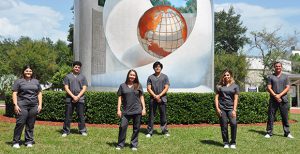
Graduates: Cynthia Cespedes (left), Mario Lozano, Ashley Burns, Jessie Cuellar, Luisa Hernandez-Sanchez, and Justin Jones
for the easy way out. Do not spend every moment waiting and praying for it to pass, but embrace it, ask for strength and a new perspective that will help you move through it. For it is in the movement that you’ll find growth. Every day is a new day, every patient is a new person whose life we impact in some way, and I hope that we all strive to make that impact a positive experience.”
Upon completing SFSC’s two-year Radiography program, graduates can work as certified radiologic technologies by passing the American Registry of Radiologic Technologists (ARRT) national examination.
For more information about SFSC’s Radiology program, contact Junior Gray, director of Radiography, at 863-784-7347 or grayj@southflorida.edu.

